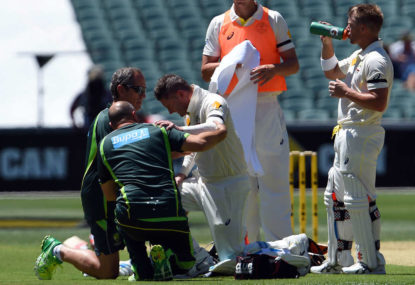With Michael Clarke admitting “there’s a chance I may never play again” in the aftermath of Australia’s thrilling Test win on Saturday evening, the Australian selectors will be forced – or should be forced – into some strategic long-term planning.
And if they’re serious about it, they’ll revisit and learn the lessons from a flamboyant young batsman named Hughes.
Not Phillip Hughes though, Kimberley John Hughes.
Back when I were a lad, the Australian cricket team had a lot of captains.
I don’t have a memory of Bob Simpson’s comeback, or Graham Yallop’s short reign, but they both happened in my lifetime. So did Ian Chappell’s leadership of Kerry Packer’s Australian team, after the media mogul famously told his prize recruit the new competition wasn’t “a f—ing democracy”.
When I was first getting into cricket, Kim Hughes was the Australian captain. When Greg Chappell didn’t feel like playing, that is. And herein lies the lesson.
Kim Hughes captained his country 28 times, for four wins and 13 losses. And sure, it was at the height of the fearsome superpowers of the West Indies, and it was little wonder he resigned from the job in tears.
But such was the level of ‘fly by the seat of your pants’ decision making on the Australian Cricket Board at the time, that Hughes’ 28 Tests at the helm came in four stints.
His first came when he succeeded an injured Yallop during the World Series Cricket period; the second and third when Chappell declared himself unavailable for tours to England and Pakistan, and then finally when Chappell himself stood down after the 1982-1983 Ashes win.
Two Australian summers later, Hughes had stood down himself, and played only two more Tests after that.
Michael Clarke has essentially ruled himself out of the remainder of the current Border-Gavaskar series, and with three Tests, and the one-day Tri-Series and World Cup to follow, and then 2015 tours to the Caribbean and England after that, here’s where the planning and future-proofing becomes important.
The ODIs and the World Cup aren’t so much the issue. George Bailey has captained the side 24 times in the last 18 months or so, and has led well. From a batting perspective, World Cup selection conversations were leading toward a choice between Clarke and Bailey anyway.
And Clarke may yet make it back for the World Cup, but he’s now suddenly very aware of all possibilities. This was where the “may never play again” quote came from on Saturday evening.
“The experts are looking at scans now, I don’t know exactly how long I’m going to be out for,” Clarke said post-match in Adelaide.
“I think the World Cup, our first practice game is eight weeks away; I’d love to take part in the Tri-Series, I’d love to take part in the World Cup but I just have to wait and see.
“There’s no doubt there’s certainly a chance [I could miss the World Cup]; there’s a chance I may never play again. I hope that’s not the case and I’ll be doing everything in my power to get back out on the park. But I have to be realistic as well.”
The issue is not the one-day side, the issue is around the Test team, particularly.
The very simple decision would be to name Brad Haddin as the interim Test captain, be that for three, five, 10, or however many Tests before the 2015-2016 Australian summer. Clarke would obviously like to be back somewhere in there, but nothing is certain any more.
And with Haddin already 37, the question becomes one of a stop-gap captain for anywhere between four weeks and the best part of a year, or taking a more strategic view and appointing a captain with at least some degree of selection longevity on the horizon.
That’s the other thing about Haddin, too. His Test batting average shouldn’t be what he’s judged on solely, yet it has now dipped below 34, and is in fact worse than Matthew Wade’s. But glovemanship can’t be exclusively relied on any more in the modern game, either – just asked Tim Paine, who was dropped from the Tasmanian side last week.
To me, it’s a simple decision. Haddin could well do a very good job in the interim, but the debate about his place in the side isn’t going to subside at his age and in his current form.
It makes far more sense to me at least to go with a younger option now, and let them gain invaluable experience on the job while they’re surrounded by however many players there are in the side north of 30.
The Australian side is on the cusp of major generational change within 18 months, and when that happens, the next wave of players will need a well-experienced captain, not a skipper who only just landed the job himself.
Steven Smith would be my pick right now. David Warner is another option, but the argument is not about making a case for either of them. With the decision for the Brisbane Test possibly already made, the argument is whether the selectors are viewing things with a magnifying glass or binoculars.
If it’s the former, they’ll take the easy option. If they’re smart, they’ll look further into the distance.
The last time the Australian selectors dithered with the captaincy, it took more than five years to recover. Learn from the Kim Hughes lesson. Make the long-term call now, and back the younger man.





























































































